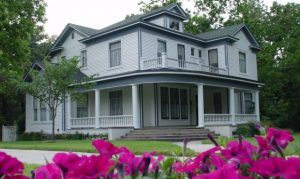Ernest Hemingway’s refuge in Northeast Arkansas continues to attract visitors
by May 31, 2017 2:02 pm 7,353 views

Ernest Hemingway and his second wife, Pauline.
The writer sat at his desk typing away inside a makeshift office in a barn loft. Through the cracks in the wood, children would stare at him, but he rarely let them know he was watching them.
It’s quite possible they were watching history unfold on a typewriter in Piggott, Arkansas. Historians think Ernest Hemingway, the Nobel Prize and Pulitzer Prize winning author, wrote part of “A Farewell to Arms,” an iconic 20th-century novel, during his many trips to Clay County, Hemingway-Pfeiffer Museum, and Educational Center Director Dr. Adam Long told Talk Business & Politics.
“He and his second wife Pauline would come here and stay in the fall … he wrote here and he liked to write in the barn,” Long said.
Hemingway, who wrote other classics such as “For Whom the Bell Tolls,” “The Old Man and the Sea,” and “The Sun Also Rises,” ultimately came to Arkansas because of a flood. High waters along waterways in Northeast Arkansas stranded Pauline’s father, Paul Pfeiffer, in Clay County. At the time his family lived in St. Louis, but he was looking for farm land in which to invest. He decided to relocate, Long said. In 1913, Pauline moved with her family to Piggott. Her father bought thousands of farm acres in the region. She eventually left to study journalism at the University of Missouri, receiving her degree in 1918.
She was working as journalist for Vogue in Paris when she met Hemingway. She was friends with Hemingway and his first wife, Hadley, but it wasn’t long before an affair simmered between Hemingway and her, according to historical accounts. He divorced Hadley and married Pauline in 1927.
The couple moved from Paris to Key West, Fla. They spent months at a time big game hunting in the western United States. In the fall, they would return to Pauline’s family home in Piggott. Hemingway loved to write in the barn loft, so the family turned it into an office, Long said.
The famed writer’s first trip to Arkansas wasn’t pleasant, he said. A scorching heat wave blistered the area. Hemingway wrote about how intolerable it was, Jones said. He had about 200 pages of “A Farewell to Arms” written when he arrived in Piggott. Subsequent trips were in the fall and the weather was more to his liking, the director said.
Hemingway spent much of his time in Piggott writing, but he also enjoyed quail hunting, and commented about how good his hunts were in this part of the state, Jones said. A school sat near his in-laws’ house, and the writer was known to take walks near there. He would challenge boys to climb drainage pipes for a nickel and do other acts of “masculinity” to amuse him, Jones said.

When “A Farewell to Arms” was made into a movie in 1932, Paramount wanted to premiere the movie in Piggott where Hemingway was staying at the time. The writer heard the movie’s ending was different than the book and it angered him to the point he didn’t attend the premiere, although his in-laws did.
The trips continued until 1940 when the couple divorced after Hemingway started an affair with another journalist. Pauline lived in Key West until her death in 1951. Hemingway married two more times and became one of the most famous writers of his generation. He split time in Cuba and Idaho before he took his own life July 2, 1961.
The home in Piggott was sold 1951 and then acquired by Arkansas State University in 1997. It became the school’s first historical heritage site. The house and barn have been restored. About 10,000 visitors come to the museum each year, Long said.
The museum is planning a special trip to Cuba in August. The itinerary includes many places frequented by Hemingway during the 21 years he spent off and on living on the island. Link here for more information about the trip.
